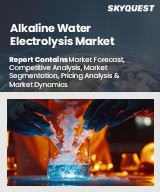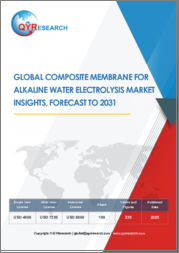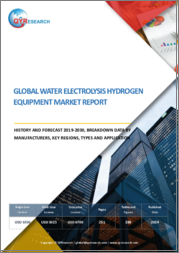
|
시장보고서
상품코드
1681009
물 전해 시장 - 세계 및 지역별 분석 : 최종 용도별, 전해조 유형별, 지역별 - 분석과 예측(2025-2034년)Water Electrolysis Market - A Global and Regional Analysis: Focus on End-Use Application, Electrolyzer Type, and Region - Analysis and Forecast, 2025-2034 |
||||||
전해조는 전기를 이용하여 물을 수소와 산소로 분해하는 시스템입니다.
이 공정은 전기 분해로 알려져 있으며, 주로 수소를 생성하는 데 사용되며, 수소는 압축 가스 또는 액화 가스로 저장됩니다. 전기분해 과정에서 생성된 산소는 대기 중으로 방출되거나 다른 용도로 사용하기 위해 저장됩니다.
국제에너지기구(IEA)는 2040년까지 에너지 수요가 25%에서 30%까지 증가할 것으로 예측하고 있으며, 기업과 정부는 지속 가능하고 저탄소 배출이 가능한 에너지원을 찾기 위해 노력하고 있습니다. 수소는 미래의 연료로 불리며, IEA는 물의 전기분해로 수소를 생산함으로써 연간 8억 3,000만 톤의 CO2가 대기 중으로 유입되는 것을 막을 수 있을 것으로 예측했습니다. 또한, 수소연료전지차, 그린 암모니아, 그린 메탄올 및 기타 용도에 대한 수요 증가는 물 전기분해 시장의 성장을 가속하고 있습니다.
수전해는 1789년 네덜란드 상인 Jan Rudolph Deiman과 Adriaan Paets van Troostwijk에 의해 처음 도입된 오래된 기술입니다. 그는 금 전극과 정전기 발생 장치를 사용하여 물에 정전기 방전을 발생시켰습니다. 그로부터 약 100년 후인 1888년 러시아 기술자 드미트리 라치노프(Dmitry Lachinov)가 수소와 산소를 생성하는 최초의 산업용 물 전해조를 개발하였고, 1960년대 중반에는 제너럴 일렉트릭(General Electric)이 제미니 우주 프로그램을 위해 양성자 교환막 공정을 도입하여 수소 생산에 적용하였습니다. 채택되었습니다. 현재 시중에서 판매되는 전해조는 4가지 유형이 있으며, 알칼리 및 고체 고분자 전해질막(PEM)은 이미 상용화되었고, 음이온 교환막(AEM)과 고체 산화물은 상용화 초기 단계에 있습니다.
수전해 시장의 성장은 수소 및 암모니아 시장과 밀접한 관련이 있습니다. 수전해는 클린 수소 생산 방법 중 하나이며, 배출물이 없고 수소 생산에 사용되는 원료가 물이기 때문에 지속가능성이 높습니다. 그린 수소와 녹색 암모니아에 대한 수요 증가는 수전해 시장 성장의 주요 촉진요인 중 하나입니다.
세계의 물 전기분해 시장에 대해 조사했으며, 시장 개요와 함께 최종 용도별/전해조 유형별/지역별 동향, 시장 진출기업 프로파일 등의 정보를 전해드립니다.
목차
주요 요약
제1장 시장 : 업계 전망
- 동향 : 현재 및 향후 영향 평가
- 이해관계자 분석
- 시장 역학 개요
- 규제 상황
- 특허 분석
- 스타트업 상황
- 공급망 분석
- 밸류체인 분석
- 세계 가격 분석
- 업계 매력
- 앞으로의 길
- 그린 수소 시장 스냅샷
- 그린 암모니아 시장 스냅샷
제2장 물 전해 시장(용도별)
- 용도 세분화
- 용도 요약
- 물 전해 시장(최종 용도)
제3장 물 전해 시장(제품별)
- 제품 세분화
- 제품 요약
- 물 전해 시장(전해 장치 유형별)
제4장 물 전해 시장(지역별)
- 물 전해 시장(지역별)
- 북미
- 유럽
- 아시아태평양
- 기타 지역
제5장 시장 - 경쟁 벤치마킹과 기업 개요
- 향후 전망
- 지역적 평가
- 기업 개요
- Asahi Kasei Corporation
- Nel ASA
- thyssenkrupp AG
- Cummins Inc.
- Toshiba Energy Systems & Solutions Corporation
- Teledyne Energy Systems Inc.
- Suzhou Green Hydrogen Energy Co., Ltd.
- Suzhou Jingli Hydrogen Production Equipment Co., Ltd.
- ITM Power PLC
- Clean Power Hydrogen Group Limited
- Plug Power Inc.
- Hitachi Zosen Corporation
- John Cockerill
- Siemens Energy AG
- McPhy Energy S.A.
- Enapter AG
- Elogen
- h2e Power Systems Pvt. Ltd.
- Ohmium
- Hystar
제6장 조사 방법
LSH 25.03.25Global Water Electrolysis Market Industry Overview
An electrolyzer is a system that breaks water into hydrogen and oxygen with the help of electricity. This process is known as electrolysis and it is mainly used to produce hydrogen, which is then stored as a compressed or liquefied gas. Oxygen produced during the electrolysis process is either released into the atmosphere or is stored to use for other purposes.
International Energy Agency (IEA) has projected that the energy demand will grow between 25% to 30% by 2040 with companies and governments trying to find sustainable and low-carbon emission energy sources. Hydrogen is being called the fuel of the future and IEA has projected that hydrogen production from water electrolysis can prevent the 830 million tons of CO2 annually from entering the atmosphere. Moreover, the growing demand for hydrogen fuel cell vehicles, green ammonia, green methanol, and other applications is driving the growth of the water electrolysis market.
Water Electrolysis Market Lifecycle Stage
Water electrolysis is old technology and was first introduced in 1789 by the Dutch merchants Jan Rudolph Deiman and Adriaan Paets van Troostwijk, who used gold electrodes and an electrostatic generator to produce an electrostatic discharge in water. Almost 100 years later in 1888, Russian engineer Dmitry Lachinov developed the first industrial water electrolyzer for producing hydrogen and oxygen. In the mid-1960s, General Electric introduced the proton exchange membrane process for the Gemini Space Program, and it was later adopted for hydrogen production. Currently, there are four types of electrolyzers available in the market alkaline and polymer electrolyte membrane (PEM) already commercialized and anion exchange membrane (AEM) and solid oxide at an early stage of commercialization.
Industrial Impact
The growth of the water electrolysis market is closely tied to the hydrogen and ammonia market. Water electrolysis is one of the clean methods for the production of hydrogen and is highly sustainable as there are no emissions and the feedstock used for hydrogen production is water. The growing demand for green hydrogen and green ammonia are among the major drivers of the growth of the water electrolysis market.
Market Segmentation:
Segmentation 1: by End-Use Application
- Transportation/Mobility Industry
- Refining Industry
- Power and Energy Storage
- Ammonia Production
- Methanol Production
- Other End-Use Applications
Segmentation 2: by Electrolyzer Type
- Alkaline Electrolyzer
- Proton Exchange Membrane (PEM) Electrolyzer
- Solid Oxide Electrolyzer Cell (SOEC)
- Anion Exchange Membrane (AEM) Electrolyzers
The water electrolysis market is dominated by alkaline electrolyzers owing to the large-scale application of alkaline water electrolysis. Moreover, the first commercialized water electrolysis systems were based on alkaline water electrolysis. The low cost and technological maturity of alkaline water electrolyzers further support the dominant share of these electrolyzers in the market.
Segmentation 3: by Region
- North America - U.S., Canada, and Mexico
- Europe - Germany, France, Netherlands, U.K., Spain, and Rest-of-Europe
- Asia-Pacific - China, Japan, India, South Korea, Australia, and Rest-of-Asia-Pacific and Japan
- Rest-of-the-World - South America, Middle East and Africa
Asia-Pacific and Japan are anticipated to gain traction in terms of the water electrolysis market owing to the presence of a large number of players, growing demand for green hydrogen, investment from the government, and the large fleet of fuel-cell vehicles in the region. Moreover, the rising demand for green ammonia and the development of hydrogen infrastructure in the region are expected to further support the dominant share of the region in the market.
Recent Developments in the Water Electrolysis Market
- In June 2022, Bosch announced that it will invest $1.3 billion by 2025 in hydrogen. The company has already invested significantly in fuel cell technology and the company is now planning to leverage its expertise in fuel cell technology to develop electrolyzers with an investment of $600 million by 2030.
- In June 2022, De Nora Water Technologies and Saline Water Conversion Corporation (SWCC) announced that they have expanded their partnership and had signed a memorandum of understanding (MOU) for brine mining and water electrolysis research.
- In June 2022, Hyundai Engineering & Construction (Hyundai E&C) announced that the Ministry of Trade, Industry, and Energy has chosen the company for building a water electrolysis-based hydrogen production base project. The company will be responsible for building a base for producing, storing, and transporting more than one ton of hydrogen per day.
- In May 2022, Frontier Energy Ltd. announced that it has chosen alkaline water electrolysis (AWE) as the preferred electrolysis technology for the production of green hydrogen at the Bristol Springs Solar (BSS) Project south of Perth in Western Australia. The company chose AWE over other water electrolysis technologies due to its low cost and technological robustness.
- In April 2022, ThyssenKrupp nucera announced that Air Products has selected the company for the supply of its alkaline water electrolysis technology to produce green liquid hydrogen in Casa Grande, Arizona in a 10 metric ton per day facility.
Demand - Drivers and Limitations
Following are the demand drivers for the water electrolysis market:
- Growing demand for green hydrogen for green ammonia and green methanol
- Rising investment and favorable policies from the government
- Hydrogen demand for energy storage
The market is expected to face some limitations too due to the following challenges:
- High capital investment requirement for water electrolysis
- Highly volatile prices of precious metals like iridium, ruthenium, and platinum used as a catalyst in water electrolysis
How Can This Report Add Value to an Organization?
Product/Innovation Strategy: The product segment helps the reader understand the different types of electrolyzers available for deployment and their potential globally. Moreover, the study provides the reader with a detailed understanding of the water electrolysis market by end-use application (transportation, refining, power, and energy generation, ammonia production, green hydrogen production, and other end-use applications) and by electrolyzer type (alkaline electrolyzer, proton exchange membrane electrolyzer (PEM), anion exchange membrane electrolyzer (AEM), solid oxide electrolyzer).
Growth/Marketing Strategy: The water electrolysis market has seen major development by key players operating in the market, such as business expansion, partnership, collaboration, and joint venture. The favored strategy for the companies has been partnerships and joint ventures, to strengthen their position in the water electrolysis market. For instance, in November 2021, Plug Power Inc. announced a joint venture with SK E&S Co., ltd. to open a Gigafactory in South Korea and another joint venture with Fortescue Futureindustries Pty ltd. for a Gigafactory in Australia.
Competitive Strategy: Key players in the water electrolysis market analyzed and profiled in the study involve major water electrolyzer manufacturers. Moreover, a detailed competitive benchmarking of the players operating in the water electrolysis market has been done to help the reader understand how players stack against each other, presenting a clear market landscape. Additionally, comprehensive competitive strategies such as partnerships, agreements, and collaborations will aid the reader in understanding the untapped revenue pockets in the market.
Key Players in Water Electrolysis Market and Competition Synopsis
The companies that are profiled have been selected based on inputs gathered from primary experts and analyzing company coverage, product portfolio, and market penetration.
Some prominent names established in this market are:
Company Type 1: Electrolyzer Suppliers
- Nel ASA
- Cummins Inc.
- Plug Power Inc.
- ITM Power plc
- ThyssenKrupp
- Asahi Kasei
- Others
Companies that are not a part of the above-mentioned pool have been well represented across different sections of the report (wherever applicable).
Table of Contents
Executive Summary
Scope and Definition
Market/Product Definition
Key Questions Answered
Analysis and Forecast Note
1. Markets: Industry Outlook
- 1.1 Trends: Current and Future Impact Assessment
- 1.2 Stakeholder Analysis
- 1.2.1 Use Case
- 1.2.2 End User and Buying Criteria
- 1.3 Market Dynamics Overview
- 1.3.1 Market Drivers
- 1.3.2 Market Restraints
- 1.3.3 Market Opportunities
- 1.4 Regulatory Landscape
- 1.5 Patent Analysis
- 1.6 Start-Up Landscape
- 1.7 Supply Chain Analysis
- 1.8 Value Chain Analysis
- 1.9 Global Pricing Analysis
- 1.10 Industry Attractiveness
- 1.11 The Road Ahead
- 1.12 Snapshot of the Green Hydrogen Market
- 1.13 Snapshot of the Green Ammonia Market
2. Water Electrolysis Market (by Application)
- 2.1 Application Segmentation
- 2.2 Application Summary
- 2.3 Water Electrolysis Market (by End-Use Application)
- 2.3.1 Refining Industry
- 2.3.2 Power and Energy Storage
- 2.3.3 Ammonia Production
- 2.3.4 Methanol Production
- 2.3.5 Transportation/Mobility Industry
- 2.3.6 Other End-Use Applications
3. Water Electrolysis Market (by Product)
- 3.1 Product Segmentation
- 3.2 Product Summary
- 3.3 Water Electrolysis Market (by Electrolyzer Type)
- 3.3.1 Alkaline Electrolyzer
- 3.3.2 Proton Exchange Membrane (PEM) Electrolyzer
- 3.3.3 Solid Oxide Electrolyzer Cell (SOEC)
- 3.3.4 Anion Exchange Membrane (AEM) Electrolyzers
4. Water Electrolysis Market (by Region)
- 4.1 Water Electrolysis Market (by Region)
- 4.2 North America
- 4.2.1 Regional Overview
- 4.2.2 Driving Factors for Market Growth
- 4.2.3 Factors Challenging the Market
- 4.2.4 Key Companies
- 4.2.5 Application
- 4.2.6 Product
- 4.2.7 U.S.
- 4.2.7.1 Market by Application
- 4.2.7.2 Market by Product
- 4.2.8 Canada
- 4.2.8.1 Market by Application
- 4.2.8.2 Market by Product
- 4.2.9 Mexico
- 4.2.9.1 Market by Application
- 4.2.9.2 Market by Product
- 4.3 Europe
- 4.3.1 Regional Overview
- 4.3.2 Driving Factors for Market Growth
- 4.3.3 Factors Challenging the Market
- 4.3.4 Key Companies
- 4.3.5 Application
- 4.3.6 Product
- 4.3.7 Germany
- 4.3.7.1 Market by Application
- 4.3.7.2 Market by Product
- 4.3.8 France
- 4.3.8.1 Market by Application
- 4.3.8.2 Market by Product
- 4.3.9 The Netherlands
- 4.3.9.1 Market by Application
- 4.3.9.2 Market by Product
- 4.3.10 Spain
- 4.3.10.1 Market by Application
- 4.3.10.2 Market by Product
- 4.3.11 U.K.
- 4.3.11.1 Market by Application
- 4.3.11.2 Market by Product
- 4.3.12 Rest-of-Europe
- 4.3.12.1 Market by Application
- 4.3.12.2 Market by Product
- 4.4 Asia-Pacific
- 4.4.1 Regional Overview
- 4.4.2 Driving Factors for Market Growth
- 4.4.3 Factors Challenging the Market
- 4.4.4 Key Companies
- 4.4.5 Application
- 4.4.6 Product
- 4.4.7 China
- 4.4.7.1 Market by Application
- 4.4.7.2 Market by Product
- 4.4.8 Japan
- 4.4.8.1 Market by Application
- 4.4.8.2 Market by Product
- 4.4.9 India
- 4.4.9.1 Market by Application
- 4.4.9.2 Market by Product
- 4.4.10 South Korea
- 4.4.10.1 Market by Application
- 4.4.10.2 Market by Product
- 4.4.11 Australia
- 4.4.11.1 Market by Application
- 4.4.11.2 Market by Product
- 4.4.12 Rest-of-Asia-Pacific
- 4.4.12.1 Market by Application
- 4.4.12.2 Market by Product
- 4.5 Rest-of-the-World
- 4.5.1 Regional Overview
- 4.5.2 Driving Factors for Market Growth
- 4.5.3 Factors Challenging the Market
- 4.5.4 Key Companies
- 4.5.5 Application
- 4.5.6 Product
- 4.5.7 South America
- 4.5.7.1 Market by Application
- 4.5.7.2 Market by Product
- 4.5.8 Middle East and Africa
- 4.5.8.1 Market by Application
- 4.5.8.2 Market by Product
5. Markets - Competitive Benchmarking & Company Profiles
- 5.1 Next Frontiers
- 5.2 Geographic Assessment
- 5.3 Company Profiles
- 5.3.1 Asahi Kasei Corporation
- 5.3.1.1 Overview
- 5.3.1.2 Top Products/Product Portfolio
- 5.3.1.3 Top Competitors
- 5.3.1.4 Target Customers
- 5.3.1.5 Key Personnel
- 5.3.1.6 Analyst View
- 5.3.1.7 Market Share
- 5.3.2 Nel ASA
- 5.3.2.1 Overview
- 5.3.2.2 Top Products/Product Portfolio
- 5.3.2.3 Top Competitors
- 5.3.2.4 Target Customers
- 5.3.2.5 Key Personnel
- 5.3.2.6 Analyst View
- 5.3.2.7 Market Share
- 5.3.3 thyssenkrupp AG
- 5.3.3.1 Overview
- 5.3.3.2 Top Products/Product Portfolio
- 5.3.3.3 Top Competitors
- 5.3.3.4 Target Customers
- 5.3.3.5 Key Personnel
- 5.3.3.6 Analyst View
- 5.3.3.7 Market Share
- 5.3.4 Cummins Inc.
- 5.3.4.1 Overview
- 5.3.4.2 Top Products/Product Portfolio
- 5.3.4.3 Top Competitors
- 5.3.4.4 Target Customers
- 5.3.4.5 Key Personnel
- 5.3.4.6 Analyst View
- 5.3.4.7 Market Share
- 5.3.5 Toshiba Energy Systems & Solutions Corporation
- 5.3.5.1 Overview
- 5.3.5.2 Top Products/Product Portfolio
- 5.3.5.3 Top Competitors
- 5.3.5.4 Target Customers
- 5.3.5.5 Key Personnel
- 5.3.5.6 Analyst View
- 5.3.5.7 Market Share
- 5.3.6 Teledyne Energy Systems Inc.
- 5.3.6.1 Overview
- 5.3.6.2 Top Products/Product Portfolio
- 5.3.6.3 Top Competitors
- 5.3.6.4 Target Customers
- 5.3.6.5 Key Personnel
- 5.3.6.6 Analyst View
- 5.3.6.7 Market Share
- 5.3.7 Suzhou Green Hydrogen Energy Co., Ltd.
- 5.3.7.1 Overview
- 5.3.7.2 Top Products/Product Portfolio
- 5.3.7.3 Top Competitors
- 5.3.7.4 Target Customers
- 5.3.7.5 Key Personnel
- 5.3.7.6 Analyst View
- 5.3.7.7 Market Share
- 5.3.8 Suzhou Jingli Hydrogen Production Equipment Co., Ltd.
- 5.3.8.1 Overview
- 5.3.8.2 Top Products/Product Portfolio
- 5.3.8.3 Top Competitors
- 5.3.8.4 Target Customers
- 5.3.8.5 Key Personnel
- 5.3.8.6 Analyst View
- 5.3.8.7 Market Share
- 5.3.9 ITM Power PLC
- 5.3.9.1 Overview
- 5.3.9.2 Top Products/Product Portfolio
- 5.3.9.3 Top Competitors
- 5.3.9.4 Target Customers
- 5.3.9.5 Key Personnel
- 5.3.9.6 Analyst View
- 5.3.9.7 Market Share
- 5.3.10 Clean Power Hydrogen Group Limited
- 5.3.10.1 Overview
- 5.3.10.2 Top Products/Product Portfolio
- 5.3.10.3 Top Competitors
- 5.3.10.4 Target Customers
- 5.3.10.5 Key Personnel
- 5.3.10.6 Analyst View
- 5.3.10.7 Market Share
- 5.3.11 Plug Power Inc.
- 5.3.11.1 Overview
- 5.3.11.2 Top Products/Product Portfolio
- 5.3.11.3 Top Competitors
- 5.3.11.4 Target Customers
- 5.3.11.5 Key Personnel
- 5.3.11.6 Analyst View
- 5.3.11.7 Market Share
- 5.3.12 Hitachi Zosen Corporation
- 5.3.12.1 Overview
- 5.3.12.2 Top Products/Product Portfolio
- 5.3.12.3 Top Competitors
- 5.3.12.4 Target Customers
- 5.3.12.5 Key Personnel
- 5.3.12.6 Analyst View
- 5.3.12.7 Market Share
- 5.3.13 John Cockerill
- 5.3.13.1 Overview
- 5.3.13.2 Top Products/Product Portfolio
- 5.3.13.3 Top Competitors
- 5.3.13.4 Target Customers
- 5.3.13.5 Key Personnel
- 5.3.13.6 Analyst View
- 5.3.13.7 Market Share
- 5.3.14 Siemens Energy AG
- 5.3.14.1 Overview
- 5.3.14.2 Top Products/Product Portfolio
- 5.3.14.3 Top Competitors
- 5.3.14.4 Target Customers
- 5.3.14.5 Key Personnel
- 5.3.14.6 Analyst View
- 5.3.14.7 Market Share
- 5.3.15 McPhy Energy S.A.
- 5.3.15.1 Overview
- 5.3.15.2 Top Products/Product Portfolio
- 5.3.15.3 Top Competitors
- 5.3.15.4 Target Customers
- 5.3.15.5 Key Personnel
- 5.3.15.6 Analyst View
- 5.3.15.7 Market Share
- 5.3.16 Enapter AG
- 5.3.16.1 Overview
- 5.3.16.2 Top Products/Product Portfolio
- 5.3.16.3 Top Competitors
- 5.3.16.4 Target Customers
- 5.3.16.5 Key Personnel
- 5.3.16.6 Analyst View
- 5.3.16.7 Market Share
- 5.3.17 Elogen
- 5.3.17.1 Overview
- 5.3.17.2 Top Products/Product Portfolio
- 5.3.17.3 Top Competitors
- 5.3.17.4 Target Customers
- 5.3.17.5 Key Personnel
- 5.3.17.6 Analyst View
- 5.3.17.7 Market Share
- 5.3.18 h2e Power Systems Pvt. Ltd.
- 5.3.18.1 Overview
- 5.3.18.2 Top Products/Product Portfolio
- 5.3.18.3 Top Competitors
- 5.3.18.4 Target Customers
- 5.3.18.5 Key Personnel
- 5.3.18.6 Analyst View
- 5.3.18.7 Market Share
- 5.3.19 Ohmium
- 5.3.19.1 Overview
- 5.3.19.2 Top Products/Product Portfolio
- 5.3.19.3 Top Competitors
- 5.3.19.4 Target Customers
- 5.3.19.5 Key Personnel
- 5.3.19.6 Analyst View
- 5.3.19.7 Market Share
- 5.3.20 Hystar
- 5.3.20.1 Overview
- 5.3.20.2 Top Products/Product Portfolio
- 5.3.20.3 Top Competitors
- 5.3.20.4 Target Customers
- 5.3.20.5 Key Personnel
- 5.3.20.6 Analyst View
- 5.3.20.7 Market Share
- 5.3.1 Asahi Kasei Corporation



















